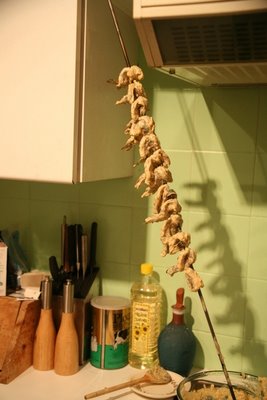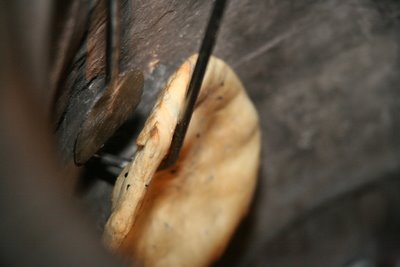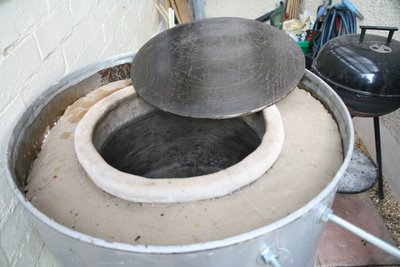Day 9. Objective: Finish clay construction.
We got to the top!In this photo you can see me using the cardboard template to start shaping the rim. The final slabs of clay were 10cm wide and protruded by about 5cm giving nearly enough clay to form a rim.

And the finished pot!

I've done a little diagram below to show roughly what shape a rim should be. I didn't quite get this to begin with, so I had to do a lot of moulding backwards and forwards until my wife bought a sense of perspective. The rim is just a reinforcement of the wall to give it some extra strength, as shown by the grey shaded piece. The rim I constructed added a flat piece on top, but the important element is the shaded section which sits on top of the clay walls.

On closer inspection, the tandoor book shows pictures of the rim being built exactly like the diagram shows.
I'm very pleased with the quality of the work, even if the inside of the pot won't be winning any construction awards. I've still got the last piece of pottery I did before this - a hideous, rubbish, mishapen "cup" I made when I was about 13. This is so much better.

The rim of the pot sat about 1cm above the top of the oil drum when I had finished. Overnight it seems to have settled to the same height. I've also added two coach bolts to hang the tandoor skewers on while the food is resting.

To celebrate this success, I went with my wife and parents to our local curry restaurant. We all ordered tandoori food and probably spent as much time looking at the size of the skewer holes and the texture of the marinade as eating. The restaurant staff were absolutely amazed that I was building a tandoor oven, and gave me some useful contacts for catering equipment and a free tandoor skewer! They also invited me back tomorrow (or next week) for a marinade and tandoor lesson and they seem genuinely excited by this project!
The next big stage is firing. The pot will have been air drying for about 36 hours since we last did any work on it. We need to "season" the inside surface with jaggery
^ and then gently build up the heat over several hours. The jaggery is solidified sugar cane sap and tastes like a cross between fudge and molasses. I hope I've got enough because I keep nibbling at it.
I've got two big bags of charcoal but no thermometer capable of going up to anything like 1000°C. Charcoal was original used before the invention of coke to smelt iron from ore, which needs 1530°C, so getting the temperatures we need is theoretically possible. I'm planning to use a
chart of glowing metal colours which suggests that the firing temperature will have the (inside of the) pot glowing between dark orange and white hot.


















































